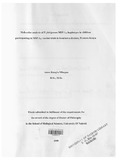| dc.description.abstract | Phase lb and lib paediatric clinical trials in children between the ages of 12 and 4X months were conducted in Kombcwa division, western Kenya between 2003 and 2006. where the safety and efficacy of Falciparum Merozoite Protein-1 (I MIM). a merozoite surface protein- 142 (MSP-Uj) malaria vaccine were tested. MSP-11> comprises MSP-I w which elicits protective humoral immune responses according to prcclinicnl studies, and MSP-1 » that contains T cell epitopes believed to be essential lor supporting the induction of immunity. Limited but significant polymorphisms occur within the conserved (.'-terminal block of the msp-l gene, where four key single nucleotide polymorphisms (SNPs)(E Q. I K. S \ and K G) are present and allow for the definition of the dominant MSP-1 m haplotypcs in mixed clone infections.
I MPI was developed from the 3D7 I’laMtunlium strain which has the ETSR MSP-I lohaplotypc and it is not known whether this vuccinc would generate an effective immune response against parasite with various MSP-1 ,g haplotypcs in natural infections and whether this would be significant with regard to overall vaccine efficacy.
The work described here constitutes the molecular analysis of MSP-I ighaplolypes of infecting parasites in vaccinated and non-vaecinated children in a phase lb and a phase lib trial. The phase I b trial had three FMP1 vaccine dose cohorts (10 ng. 25 pg and 50 pg) and a rabies vaccine control arm. while the Phase lib had the full vaccine dose (50 pg) arm and a rabies vaccine control arm. In the phase I trial ge no typing of DNA samples was done at enrolment and one month post-vaccination by PCR-sequencing and by Real I ime quantitative PCR (RT-qPC'R) so as to validate the latter assay. For sequencing analysis, a 400 bp umplicon covering all of block 17 of the msp-l gene which encodes MSP-1|.< was amplified from each sample and then sequenced before determining the MSP-I i« haplolypc. I laplotypes resolved by RT-qPCR involved first determining the dominant allele at each MSP-11« SNP using the threshold cycle
(Cl) values of each allele before linking together these alleles. Analysis of MSP-114 huplotypcs for the Phase lib study was conducted at enrolment, one month post-vaccination and for children with clinical malaria using l< I -qPCR. Haplotype prevalence was then compared between the vaccine and control groups.
Might different MSP-1 w haplotypes were identified from the sequence data (LKNG. FKSG. F.KSR. L TNG. LI SR. QKNG. QKSG and QKSR) and by R I -qPCR (F.KNG. EKSR. FTN(i. HTSR. QKNG. QkSR. QTN(i and QISR). Haplotype prevalence at enrolment determined through direct sequencing of PCR products revealed a predominance of LK.NG (49%) and QKNG (40%) while ii 1 SR. the vaccine haplotype. represented only 3% of these infections with other lesser prevalent huplotypcs (EKSR. FKSG. HTNG and QKS(j) together constituting the remaining 8% The R 1-qPCR results for predicted MSP-1haplotypes were highly comparable to sequencing: 73% agreement at Day 0 and ‘>1% agreement at Day 90.
Six different MSP-I ,q haplotypes (LKNG. F.KSR. HTNG. IfI SR. QKNG and QKSR etc) were predicted from the RT-qPCR allele data in the phase lib trial. At enrolment. F.KNG and QKNG were still the major MSP-11« haploty pes as predicted from RT-qPCR (KKNG 65%. QKNG 16%). Other haplotypes were at lower levels with FKSR at 13%. the vaccine haplotype (L I SR) at 4% and QKSR and HTN(j together making up the remaining 2%. While the predicted haplotype frequencies following vaccination did not differ between the vaccine and control groups among asymptomatic children at one month post-vaccination, significantly fewer I alleles were observed in the vaccine group (49%) at one month post-vaccination (95% C’l 38% - 60%) compared to the control group (64%. 95% Cl 53% - 73%. P 0.04). Comparison of the complete haplotypes in 381 children (176 voccinees and 205 controls) who had one or more malaria episodes post-vaccination indicated no significant difference in haplotype distribution between the vaccine and control groups when considered altogether or ns separate episodes. However, among children who fell sick during the first four months following vaccination there
was a significant lower prevalence of the H allele among vaccines: 54% (95%('l 42% - 65%) compared to 69% (95%C'I 58% - 79%. I* - 0.04> in the controls. In addition, a trend towards significance (p - 0.08) was noted in the time to first clinical episode with the vaccine haplotype (L1 SR) among \aecinees suggesting a vac cine-induced delay.
I he results from the phase lb showed that the RT-qPCR assay developed was reliable for haplotyping. Furthermore, the observations from the pluise lib trial implied that FMPI induced a subtle homologous effect on parasites with the liTSR haplotype. This was the expectation based on previous investigations that examined the specificity of antibodies generated hv FMPI. The results also support previous observations that suggest that effective immune responses induced by FMPI seem to be diminished in malaria exposed populations, Given the apparent low level homologous impact and the absence of any detectable effect on heterologous haplotype strains, consideration must be given toward boosting the efficacy of I MP1 through the testing and possible combination with antigens from other strains or other vaccine candidate antigen altogether. Future studies should address these concerns and also unequivocally substantiate the vaccine effects noted in this study | en_US |



